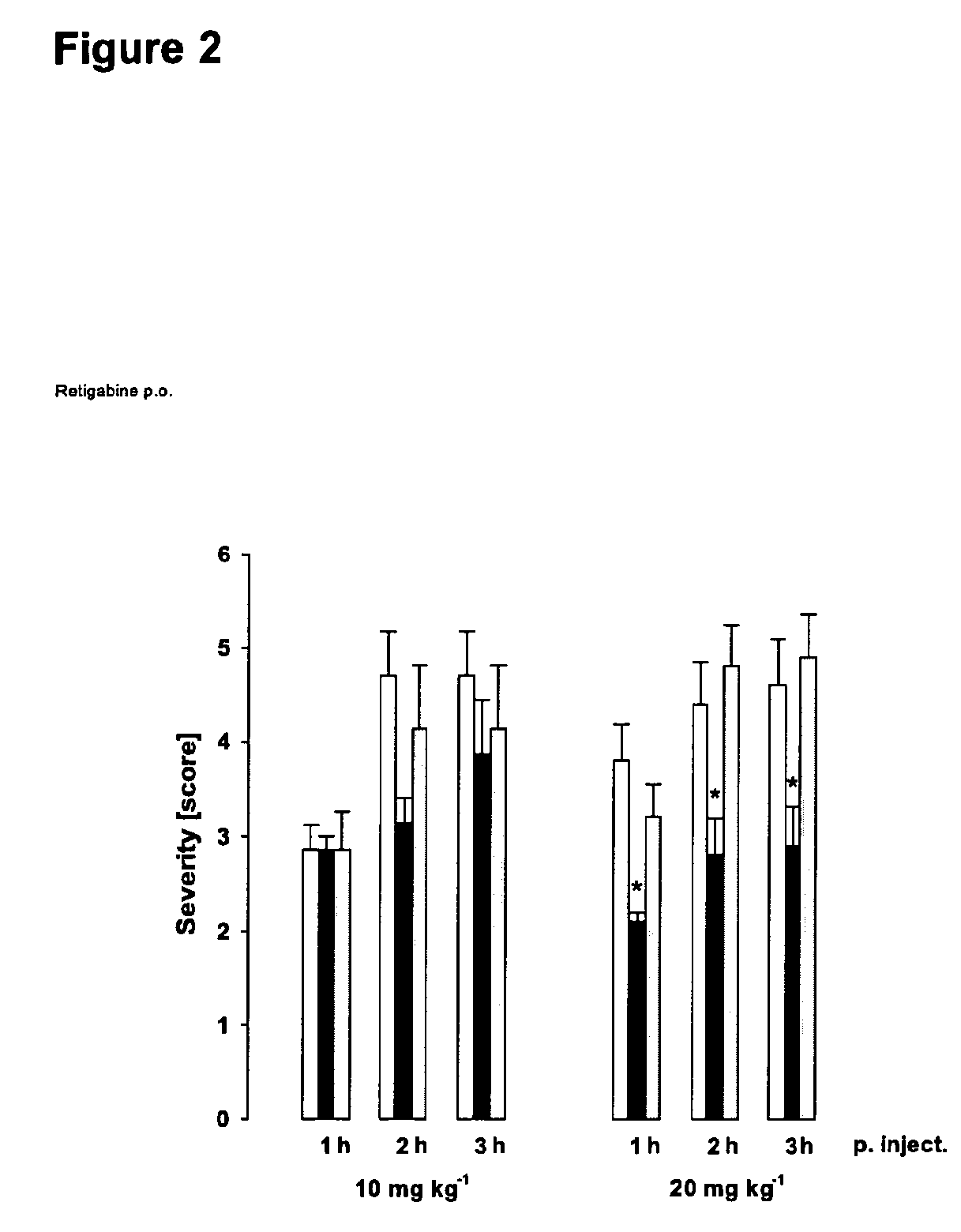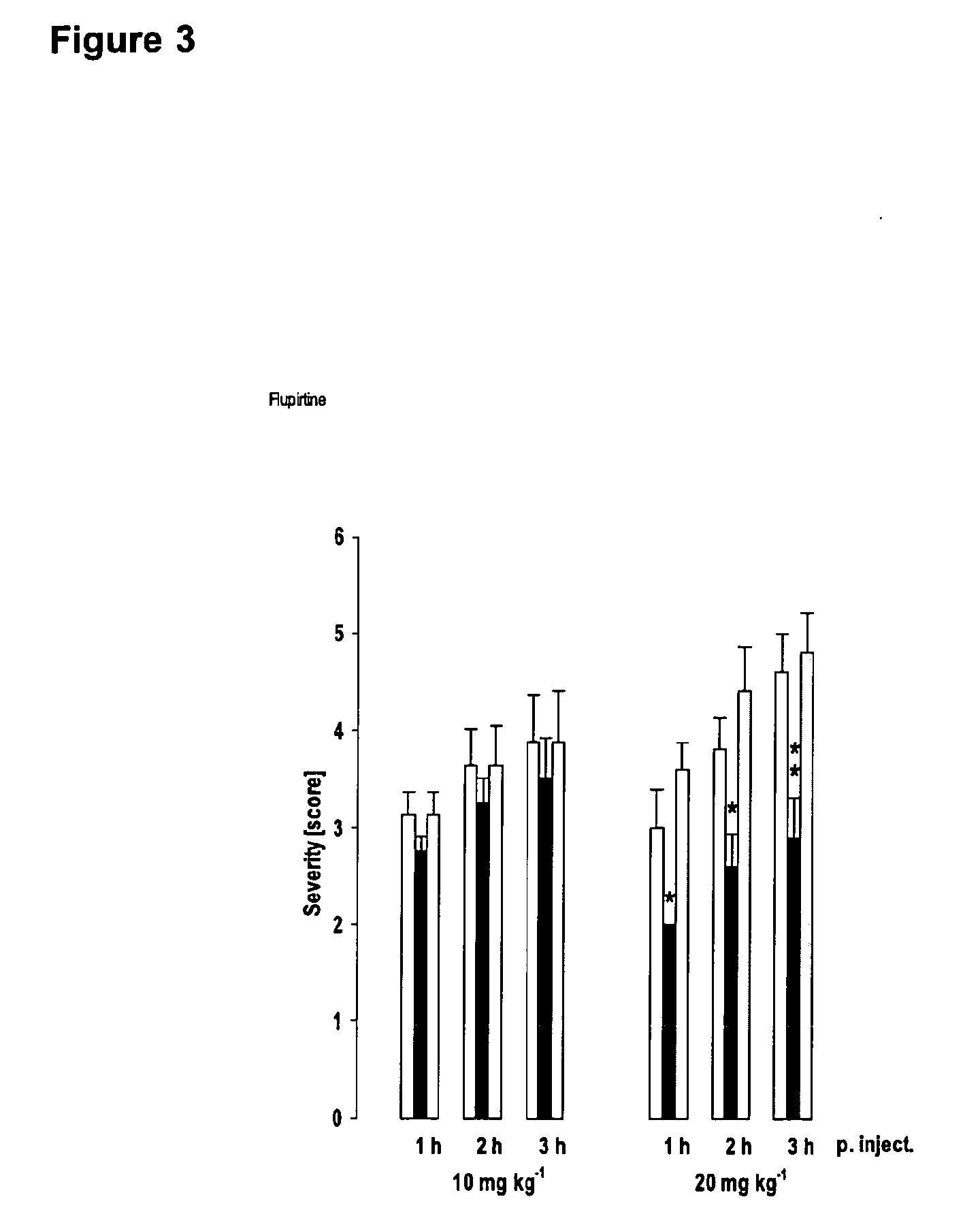Potassium Channel Activators for the Prevention and Treatment of Dystonia and Dystonia-Like Symptoms
a potassium channel and activator technology, applied in the field of dystonia and dystonia-like symptoms, can solve the problems of tardive dystonia, changes in voice, strangled or whispering quality, neck twisting into unusual positions or postures, etc., to suppress dystonia symptoms, hyperpolarization of membrane potential, and hyperpolarization of neuronal cells
- Summary
- Abstract
- Description
- Claims
- Application Information
AI Technical Summary
Benefits of technology
Problems solved by technology
Method used
Image
Examples
example 1
Examinations of Retigabine and Flupirtine in the dtsz Mutant Hamster
[0076]Aim: We investigated the anti-dystonic effect of neuronal potassium channel activators in a predictive model of paroxysmal dystonia. To evaluate the role of different neuronal potassium channels, the selective activator of Kv7 channels, retigabine was used. In addition, flupirtine, which is known to activate inward rectifying potassium channels and Kv7 potassium channels, was used.
Materials and Methods
[0077]Animals The dtsz mutant hamsters (Syrian golden hamsters), used in the present experiments, were obtained by selective breeding as described in detail elsewhere (Richter and Löscher, 1998). In this inbred line of mutant hamsters the motor disturbances are transmitted by a recessive gene. All animal groups consisted of male and female hamsters, because there was no indication of sex-related differences in the severity of dystonia or in the response to drugs (Richter and Löscher, 1998). The animals were born ...
example 2
Effects of the Kv7.2 / 7.3 Channel Blocker XE-991 in the dtsz Mutant Hamster, a Model of Paroxysmal Dystonia
[0118]Aim: With regard to the antidystonic effects of the potassium channel openers retigabine and flupirtine (see Example 1) we examined the effects of the selective Kv7.2 / 7.3 channel blocker XE-991 (10,10-bis(4-pyridinylmethyl)-9(10H)-anthracenone) on the severity of dystonic episodes in the dtsz mutant hamster. Furthermore, we investigated if the antidystonic effects of retigabine can be counteracted by combined treatment with XE-991.
[0119]Results: The Kv7.2 / 7.3 channel blocker XE-991 caused an aggravation of dystonia, i.e., increased the maximum severity of dystonia at doses of 3 and 6 mg / kg i.p. (FIG. 4). The latency to onset of dystonia tended to be decreased after treatment with XE-991 (not illustrated). Two out of 8 animals exhibited moderate to unequivocal hyperlocomotion and moderate ataxia (up to 180 min) and marked initial facial contortions 10-20 min after administr...
example 3
Effect of Flupirtine and Retigabine as Examples for Neuronal Potassium Channel Activators in a Chronic Model of L-DOPA Induced Dyskinesia
[0122]Rational: The idiopathic Parkinson syndrome is a common neurodegenerative disease, in which a progressive degeneration of dopaminergic neurons in the substantia nigra leads to decreased striatal dopamine levels. Considering the patient profile, levodopa in combination with decarboxylase-inhibitors (e.g. benserazide) represents still the therapeutical “gold standard” in many cases. However, many patients develop dyskinesias after long-term treatment. The pathophysiology of these spontaneous involuntary dystonic and choreatic movements is unclear, but an increased activity of striatal projection neurons seems to play a critical role. These neurons express Kv7 channels i.e. one type of neuronal potassium channels, which cause a hyperpolarization after voltage-dependent activation. Based on previous observations in a mutant hamster model of parox...
PUM
| Property | Measurement | Unit |
|---|---|---|
| humidity | aaaaa | aaaaa |
| temperatures | aaaaa | aaaaa |
| movement | aaaaa | aaaaa |
Abstract
Description
Claims
Application Information
 Login to View More
Login to View More - R&D
- Intellectual Property
- Life Sciences
- Materials
- Tech Scout
- Unparalleled Data Quality
- Higher Quality Content
- 60% Fewer Hallucinations
Browse by: Latest US Patents, China's latest patents, Technical Efficacy Thesaurus, Application Domain, Technology Topic, Popular Technical Reports.
© 2025 PatSnap. All rights reserved.Legal|Privacy policy|Modern Slavery Act Transparency Statement|Sitemap|About US| Contact US: help@patsnap.com



